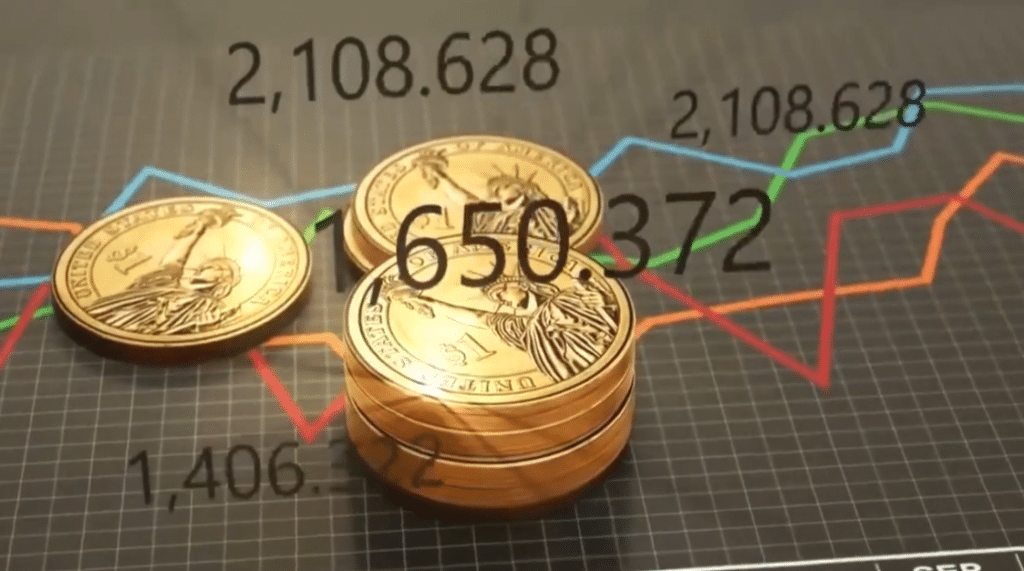Gold Price and Real Interest Rates

Did you know that nearly 80% of gold consumption worldwide is from jewelry, industry, and physical investment? However, the price of gold isn't simply driven by supply and demand. As an investor, you may have noticed a trend: when real interest rates rise, gold prices tend to fall, and when they drop, gold prices often increase. This inverse relationship seems straightforward, but it's not always that simple.
As an investor, you may have noticed a trend: when real interest rates rise, gold prices tend to fall, and when they drop, gold prices often increase. This inverse relationship seems straightforward, but it's not always that simple. To obtain a full understanding of the correlation of the gold price and real interest rates, we will discuss the following subjects:
- The Negative Correlation Explained
- Impact of Negative Real Interest Rates
- Historical Evidence of Interest Rates and Gold Prices
- The Importance of Real Interest Rate Changes
- Gold Prices During Low Real Interest Rates
There's a complex interplay at work here that can be influenced by a myriad of factors, some of which may surprise you. Intrigued? We're just scratching the surface of the fascinating dynamics between gold prices and real interest rates

The Negative Correlation Explained
While it may seem counterintuitive, the negative correlation between real interest rates and gold prices is actually a fundamental aspect of financial markets, with rising rates typically leading to a decrease in gold prices. This seemingly strange relationship boils down to the opportunity cost of holding gold. When interest rates rise, the cost of holding gold, a non-interest bearing asset, becomes higher. Why hold gold when you could invest in bonds or savings accounts and earn interest?
Let's delve into the numbers. Historical data indicates that during periods of high real interest rates, such as the early 1980s, gold prices experienced a significant downtrend. Conversely, during periods of low or negative real interest rates, like the post-financial crisis era, gold prices soared. This is no mere coincidence. It's a clear demonstration of the inverse relationship between gold prices and real interest rates.
But it's not just about the rates themselves. It's also about the market's expectations. If traders expect rates to rise, they might start selling off their gold in anticipation, driving prices down.
Remember, gold is often viewed as a safe-haven asset. In times of economic uncertainty or low interest rates, investors flock to gold, pushing prices up. When the economy stabilizes and rates rise, the rush to gold subsides, and prices typically fall.
Understanding this relationship can help you make informed investment decisions. So keep an eye on those interest rates. They might just be the key to your gold investing strategy.

Impact of Negative Real Interest Rates
In the realm of financial markets, experiencing negative real interest rates can profoundly influence the price of gold, often driving it upwards. When the inflation rate surpasses the nominal interest rate, negative real interest rates occur. Despite gold not bearing interest or dividends, creditors are more inclined to buy gold in these circumstances. It serves as a wealth store, preserving purchasing power when real interest rates dip into negative territory.
Historically, such scenarios have had significant impacts on gold prices. In the second half of the 1970s, inflation outpaced bond returns, causing investors to divert their capital into gold, leading to a price increase. Another example occurred in 2001 when the Fed reduced nominal interest rates to zero, and gold prices simultaneously skyrocketed.
Understanding these changes in real interest rates is crucial for movements in gold price. The most substantial gold market booms have occurred in negative real interest rate environments, as evidenced by the 1970s and 2000s. Conversely, when the Fed hiked expectations in 2015, causing U.S. real interest rates to rise, gold prices fell.
Even in times of low real interest rates, such as the secular bear market in gold during the 1980s and 1990s, gold prices can still gain when real interest rates are moderately positive. Understanding this impact can significantly aid your gold investment strategy, allowing you to profitably trade gold. Therefore, it's essential to monitor real interest rates closely, as they are one of the most important drivers of gold prices.
Historical Evidence of Interest Rates and Gold Prices
Let's delve into the historical evidence that underscores the inverse relationship between interest rates and gold prices, and examine how shifts in the global economy have influenced this dynamic over the years. You've probably noticed the negative correlation: when interest rates rise, gold prices tend to fall, and vice versa. This is primarily due to gold's status as a non-interest bearing asset.
Consider the high-inflation period of the late 1970s. Rising inflation outpaced nominal returns on bonds, pushing real interest rates into negative territory. Investors, seeking to preserve their wealth, flocked to gold, causing its price to surge. But when real interest rates returned to positive territory, the gold boom ended abruptly.
Fast forward to the early 2000s, when the Federal Reserve cut nominal interest rates to near zero, effectively driving real interest rates down once more. In response, the gold market experienced an upswing, with prices soaring. It's clear from these historical examples that shifts in real interest rates significantly impact the gold market.
The gold price slump in 2015 offers another illustrative example. Anticipation of a Federal Reserve rate hike, which would increase U.S. real interest rates, contributed to the fall in gold prices. This highlights the importance of keeping a keen eye on economic indicators when investing in gold.
These instances underline the vital role played by real interest rates in influencing gold prices. Understanding this correlation enables you to make more informed decisions in your gold investments.
Working with a long-established and trusted gold investment company that has studied and actively monitors the various economic cycles, central bank policy shifts, and the various movements of the markets can eliminate a great deal of the guesswork
Furthermore, they can provide serious gold investors competitive prices, transparency, a reasonable buyback policy, reliable customer service, and robust security of your precious metal investments.
Depending on whether you are a high-net investor looking for the most competitive prices or require a lower investment minimum and affordable entry to the gold market, we have researched and reviewed our best 4 gold IRA and precious metal investment companies that meet those individual needs. Whether you prefer a gold IRA or owning the physical gold in your place of residence.
Tap the banner below to visit Augusta Precious Metals to receive their gold IRA checklist
The Importance of Real Interest Rate Changes
Understanding how changes in real interest rates impact gold prices is crucial for your investment strategy. Real interest rates and gold prices exhibit a negative correlation, meaning as interest rates rise, gold prices tend to decrease. This is largely due to the increased opportunity cost of holding gold, a non-interest-bearing asset, when interest rates are high.
When real interest rates are negative, which occurs when inflation rates exceed nominal interest rates, gold prices often surge. For instance, in the second half of the 1970s, inflation was higher than bond returns, leading to a shift of investors' capital into gold and causing its price to skyrocket. This trend reversed when real interest rates returned to positive territory, ending the gold boom.
The 2000s offered another example. When the Federal Reserve slashed nominal interest rates, real interest rates dropped to zero, causing a similar surge in gold prices. Yet, when anticipated Fed rate hikes led to a rise in U.S. real interest rates in 2015, gold prices fell.
These historical patterns underline the importance of closely monitoring changes in real interest rates. They serve as key indicators for gold price movements. By understanding the relationship between real interest rates and gold prices, you'll be better equipped to make strategic investment decisions and capitalize on market trends. Remember, the greatest booms in the gold market occurred during periods of negative real interest rates. Being aware of this can help you profit from your gold investments.
Gold Prices During Low Real Interest Rates
While you've seen how negative real interest rates can drive up gold prices, it's also important to examine how gold fares during periods of low, but still positive, real interest rates. You might assume that gold prices would decrease when real interest rates are low but still in the positive range. However, historical data tells a different story.
Let's look at the early 2000s, for example. The Federal Reserve cut nominal interest rates, resulting in real interest rates hovering around zero. Contrary to expectations, gold prices soared during this period. Why? Gold, which doesn't pay interest or dividends, becomes more attractive as the opportunity cost of holding it decreases.
Now, consider the period from 1980 to 2000, often referred to as the "secular bear market" for gold. Real interest rates were low but still positive, yet gold prices remained relatively flat. This was due, in part, to the stability of the economic environment, which reduced the demand for gold as a safe haven asset.
These examples highlight that low, positive real interest rates don't necessarily lead to lower gold prices. Other factors, such as economic stability or uncertainty, can have a significant impact on gold prices. It's critical to analyze the broader economic context when considering the relationship between real interest rates and gold prices. So, while low real interest rates can create favorable conditions for gold, they don't guarantee a rise in gold prices.
Conclusion
So, you see, there's a complex dance between real interest rates and gold prices. When rates climb, gold's shine fades, yet when rates dip, gold becomes a beacon of security. But remember, it's not a simple rule - other factors can sway this relationship. History shows exceptions too. So, keep an eye on those real interest rates, they're key to understanding gold's value, especially during low rate periods. It's a data-driven dance worth mastering for your investment strategy.
Obtain a gold IRA guide and talk to a broker




If you have 100k in savings to protect, attend a gold investment educational webinar hosted by Augusta Precious Metals. Tap the button below:
Gold IRA FAQs

Adam ONeill
Author, lifelong investor, and creator of PreciousMetalsInvestmentPortfolio.com

